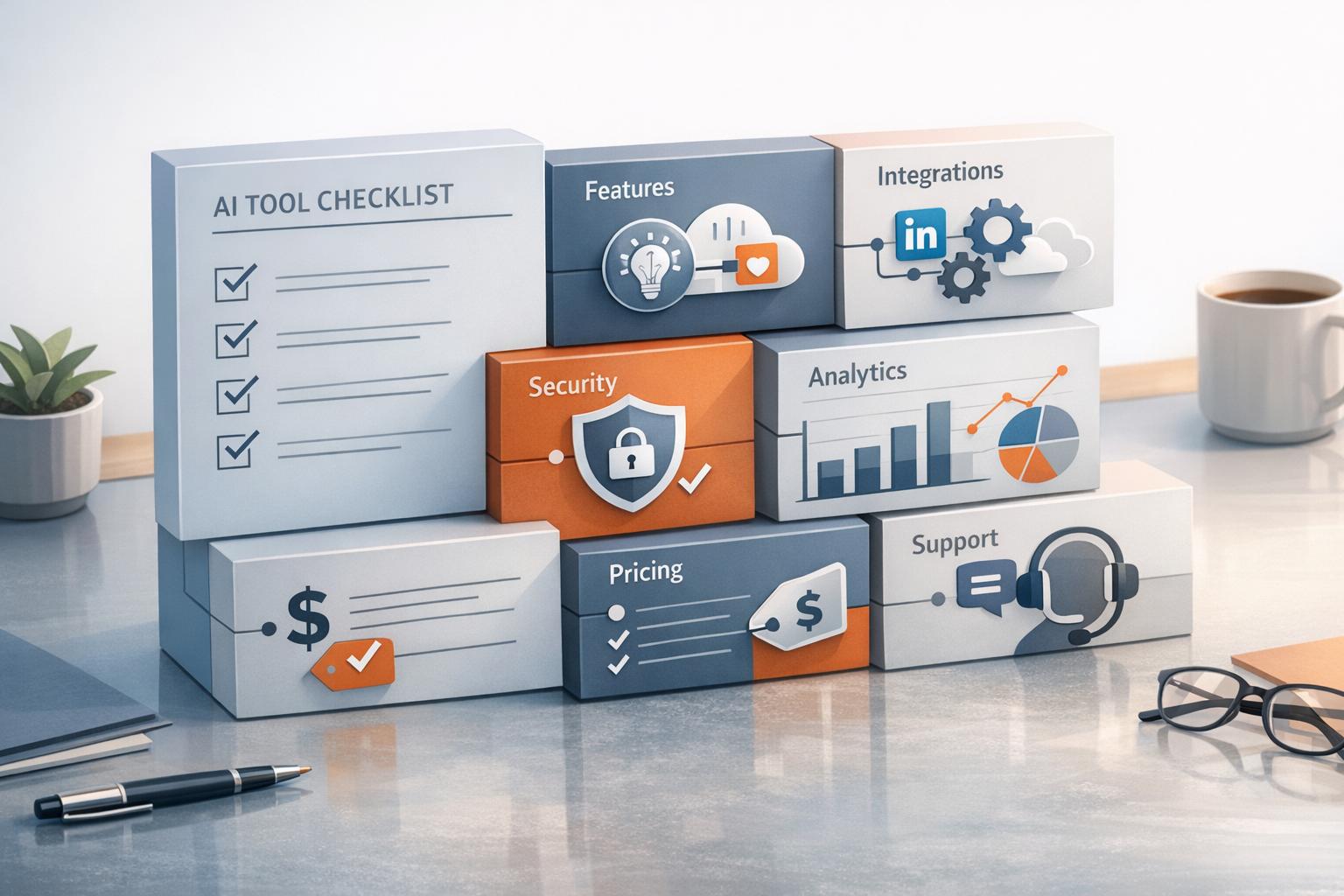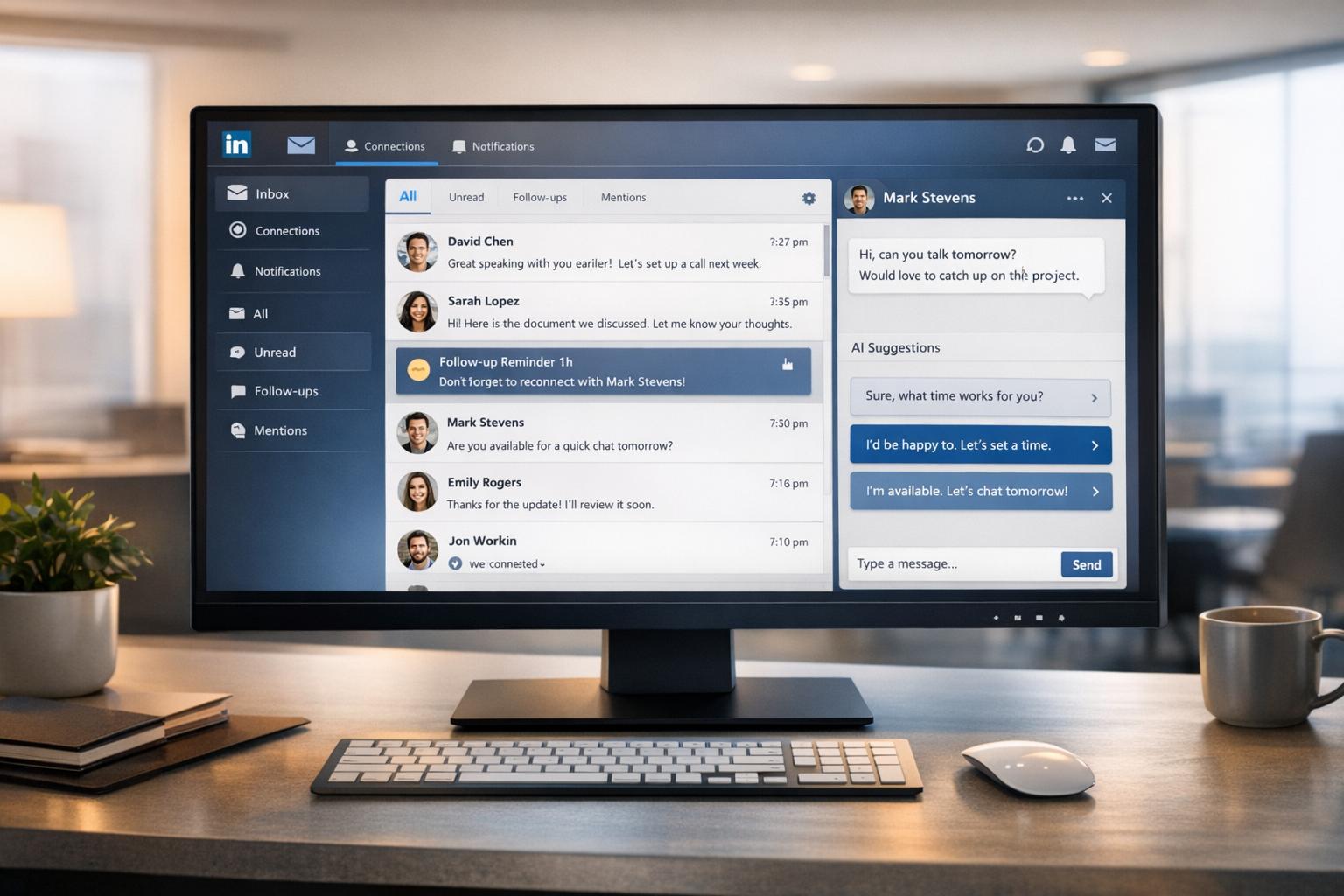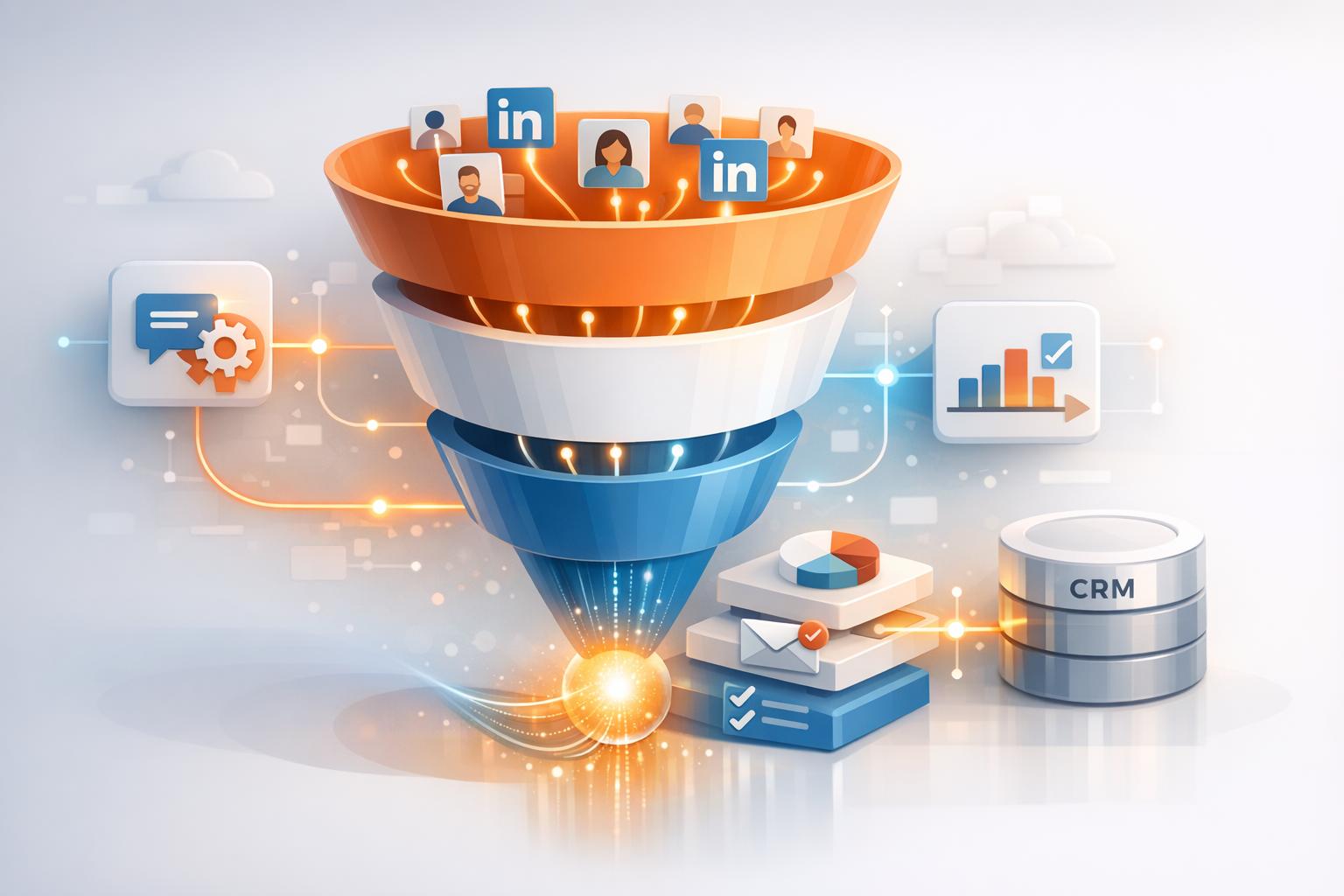
AI tools are transforming LinkedIn outreach by personalizing messaging tones to fit individual prospect personas. Instead of generic templates, AI analyzes LinkedIn profiles, behavioral data, and communication patterns to craft tailored messages. This approach improves reply rates by over 60% and connection rates beyond 55%, helping businesses generate significant pipeline growth. Tools like SalesMind AI even predict personality types (e.g., MBTI) to fine-tune tone and style.
Key Takeaways:
- AI uses data like job titles, industries, and LinkedIn activity to build detailed prospect personas.
- Messaging tone adapts to roles (e.g., C-level execs prefer data-driven messages, while startup founders respond to casual tones).
- Companies using AI-driven personalization report up to 8x higher reply rates and substantial increases in closed deals.
- Compliance with U.S. communication norms and privacy regulations is essential for effective outreach.
AI-powered tone matching scales personalization while maintaining a human touch, making it an essential tool for efficient and effective LinkedIn outreach.
Understanding Prospect Personas and Communication Styles
What Are Prospect Personas
Prospect personas are detailed, semi-fictional profiles of your ideal customers, created using real-world data from your most successful client interactions. These profiles go beyond surface-level demographics, integrating firmographic details (like industry and company size) and psychographic insights (such as professional goals and pain points).
For LinkedIn outreach, building personas involves analyzing key details - job titles, industries, company sizes, challenges, goals, and, importantly, how prospects prefer to communicate. This process often starts with reviewing CRM data and identifying patterns among your top-performing clients. By pinpointing shared traits among your most valuable prospects, you can create profiles that guide your outreach strategy.
To develop these personas effectively, you’ll need both quantitative data from tools like LinkedIn Sales Navigator and qualitative insights from your sales team’s direct conversations with prospects[1]. The aim is to understand not just what your prospects do, but how they think, what hurdles they face, and how they like to engage.
Modern AI tools can take this process a step further. By analyzing behavioral signals on LinkedIn - such as posting habits, engagement patterns, and personality indicators - AI helps refine these profiles. This deeper understanding allows sales teams to craft messages that resonate on both a professional and personal level.
This level of insight provides a strong foundation for creating messaging strategies that align with communication norms in the U.S.
Common Communication Preferences in the U.S.
Once you’ve defined your personas, the next step is tailoring your messages to fit the communication styles of U.S. professionals. In the American business world, directness, clarity, and professionalism are essential for effective LinkedIn outreach[1][2].
U.S. prospects appreciate concise, value-driven messages that get to the point quickly. In your initial message, it’s important to establish who you are, why you’re reaching out, and how you can provide value - all within the first few sentences. Efficiency is key.
Personalization also plays a huge role in building trust. Mentioning recent LinkedIn activity, shared connections, or specific industry challenges shows that you’ve taken the time to research your prospect. It’s a simple way to make your outreach feel more genuine.
The tone of your message should reflect the recipient’s role and industry. For example:
- C-level executives prefer strategic, data-backed communication that highlights business outcomes and return on investment (ROI). They want to see measurable results.
- Mid-level managers, on the other hand, are more likely to respond to practical, solution-focused messages that address their day-to-day challenges.
Striking the right balance between professionalism and human connection is crucial. Messages that feel overly robotic or pushy are often ignored. On the flip side, messages that acknowledge a prospect’s unique situation and challenges tend to stand out, leading to better engagement and response rates[1][2].
How I Automated LinkedIn DM Outreach with 2x AI Agents (Free Template Included)
How AI Maps Messaging Tone to Prospect Personas
Now that you're familiar with the communication preferences of U.S. professionals, let's dive into how AI analyzes and aligns messaging tones with your prospect personas. This process relies on advanced machine learning techniques to fine-tune your outreach efforts.
AI Data Sources and Analysis Methods
AI tools pull data from various sources to create a detailed profile of each prospect's communication style. One key source is LinkedIn profile information, which includes job titles, company details, industry background, and educational history. Beyond that, AI examines communication patterns for deeper insights.
Natural language processing (NLP) plays a central role in this analysis. By evaluating the language, tone, and content of a prospect's LinkedIn posts, comments, and profile summaries, AI can identify their preferred communication style. For example, if a prospect's posts are formal and industry-specific, the AI might suggest a professional tone. On the other hand, casual posts with personal anecdotes could prompt a conversational approach[2][3].
AI also factors in engagement history, such as the posts a prospect likes, shares, or comments on, along with the tone of their interactions. CRM data adds another layer of depth. By integrating your customer data, AI can uncover patterns in successful client relationships, helping to refine communication strategies for similar personas.
With tools like SalesMind AI, this process becomes seamless. By directly integrating with LinkedIn, the system extracts actionable insights from prospect profiles, enabling highly tailored messaging.
Adjusting Messaging Styles with AI
Once the data is analyzed, AI uses a combination of techniques - NLP, sentiment analysis, and machine learning - to adapt messaging styles to fit different personas. These tools help classify traits and match them with the appropriate tone, whether it's formal, conversational, or consultative[2][3].
Sentiment analysis is especially effective in determining whether a prospect prefers straightforward, data-driven communication or a more empathetic, narrative-driven approach. By assessing the emotional tone of a prospect's content and interactions, the AI predicts their likely response to various messaging styles.
Here’s how it works in practice: For a C-level executive at a Fortune 500 company, the AI might craft a concise, professional message focusing on ROI and strategic value. Meanwhile, for a startup founder, it might generate an enthusiastic, informal message that emphasizes innovation and shared entrepreneurial challenges[1][2]. These adjustments are based on both profile data and observed engagement patterns.
The results speak for themselves. Companies using AI-powered personalization have seen up to 8x higher reply rates and noticeable improvements in meeting bookings and deal closures[2]. For instance, in 2023, a SaaS sales team using AI-enhanced outreach increased their LinkedIn reply rate from 3% to 24% within three months. By analyzing prospect profiles and recent activity, generating personalized icebreakers, and adjusting message tone, the team achieved a 40% boost in closed deals[2].
| AI Technique | Data Source Used | Personalization Outcome |
|---|---|---|
| NLP & Sentiment | LinkedIn posts, profile, CRM | Adjusts tone (formal, casual, etc.) |
| Dynamic Variables | Profile and company data | Inserts personal details in messages |
| Engagement Analysis | Message history, CRM | Optimizes follow-up timing/content |
| A/B Testing | Message performance data | Refines tone/style for best results |
AI tools also learn from engagement metrics to continuously improve message tone. Modern systems can suggest the best follow-up timing and content based on prior interactions, reducing guesswork and boosting efficiency[1].
These intelligent adjustments form the foundation for integrating AI-powered tone matching into your LinkedIn outreach strategy.
sbb-itb-817c6a5
Setting Up AI-Powered Tone Matching in LinkedIn Outreach
To effectively use AI-powered tone matching in LinkedIn outreach, you need a clear, structured approach. This involves creating detailed persona profiles, crafting dynamic message templates, and regularly refining your strategy. Here's how you can break it down into manageable steps.
Setting Up Persona Profiles
The foundation of successful tone matching lies in building comprehensive persona profiles that go beyond surface-level details. Tools like SalesMind AI analyze LinkedIn data to predict personality traits, such as MBTI types, to align communication styles with individual preferences [4][6]. When crafting these profiles, include specifics like job title, industry, company size, location (formatted by U.S. state and city), seniority level, communication style, and recent LinkedIn activity [1][2].
For example, if the AI identifies a prospect as an "Analyst" type, it might suggest using data-driven messaging with concrete metrics and ROI-focused language. On the other hand, "Diplomat" types respond better to relationship-driven language that highlights collaboration [4][6]. Users who invest time in building detailed persona profiles often see connection rates surpass 55% and reply rates exceeding 60% [4].
Once you’ve established these profiles, you can move on to creating message templates that adapt dynamically to each persona.
Using AI-Generated Message Templates
Templates are where persona insights come to life. Start by selecting a framework and adding dynamic fields like the recipient's name, company, or recent achievements to make the outreach feel personal [2]. SalesMind AI then generates messages tailored to each persona, adjusting tone and content automatically.
For instance, the platform might use formal, technical language for IT directors, empathetic tones for HR managers, or lively, creative messaging for marketing executives. In one U.S. case study, this approach boosted positive response rates by 30% and increased booked meetings by 20% over three months [7]. For C-level executives at Fortune 500 companies, the system produces concise, professional messages, while startup founders receive more casual and energetic outreach that references recent LinkedIn posts or company milestones [1][2][7]. Additionally, SalesMind AI can handle outreach to over 200 leads per week, including managing multi-step follow-up sequences that adapt to the prospect's responses.
Reviewing and Improving AI Outputs
Even with advanced AI, human oversight remains essential. Regularly review messages to ensure they are clear, professional, and compliant with U.S. regulations. During this process, check for adherence to U.S. English standards, including spelling, grammar, date formats (MM/DD/YYYY), currency symbols ($), and measurement units [1][2]. SalesMind AI includes compliance tools to help you meet LinkedIn policies and U.S. privacy laws while avoiding excessive message frequency [5][6].
Tracking metrics like reply rates, booked meetings, and deal progression is equally important. Many users, generating over $385,000 in monthly pipeline value, use these insights to refine their strategies [4]. The platform’s unified inbox simplifies monitoring responses and engagement trends, making it easier to adjust persona profiles and messaging tactics. This iterative process allows for continuous improvement as more data and feedback are incorporated.
AI-powered tone matching thrives on refinement - it grows smarter and more effective as you provide ongoing inputs and make data-driven adjustments.
Best Practices for AI-Driven Messaging in the U.S.
Using AI for LinkedIn outreach can be a game-changer, but success hinges on balancing automation with a personal touch while staying aligned with U.S. communication norms and regulations. Here’s how to make your outreach both effective and professional.
Keeping Messages Clear and Genuine
AI-driven messaging should feel natural - like it’s coming from a real person, not a machine. A great way to achieve this is by referencing specific details from a prospect’s LinkedIn profile or recent activity. When your message reflects genuine interest, it’s far more likely to catch their attention.
Stick to straightforward, conversational language that aligns with U.S. business etiquette. For instance, instead of saying, "I would be honored to discuss potential synergies", try something more relatable, like, "I’d love to share some ideas that could help with your current challenges."
Tools like SalesMind AI let you edit and personalize messages before sending, helping you avoid generic phrasing and ensuring each message feels tailored and authentic[7]. This extra layer of human oversight can make all the difference.
Dynamic personalization is another powerful strategy. Mentioning a recent LinkedIn post, milestone, or achievement can make your outreach stand out. For example, a message like, "I really enjoyed your post about remote onboarding challenges - would love to connect and share ideas", often performs better than a generic template[1][8].
While clarity and personalization are key, staying compliant with U.S. regulations is just as important.
Following U.S. Regulations
When using AI to craft messages, it’s essential to ensure compliance with U.S. legal standards. The CAN-SPAM Act, for instance, requires clear identification, truthful messaging, and easy opt-out options for commercial communications. While LinkedIn messages aren’t emails, applying these principles shows professionalism and protects your reputation.
LinkedIn’s terms of service also prohibit spam and emphasize respectful communication. To stay compliant:
- Clearly identify yourself and your company.
- Include opt-out instructions for recipients.
- Avoid misleading language in your messages.
- Regularly review LinkedIn’s policies to ensure your outreach aligns with their guidelines.
AI tools can help by flagging language that might violate these rules and managing opt-out requests seamlessly[8].
Transparency and respect are cornerstones of professional communication in the U.S. Always be upfront about who you are, provide genuine value in your outreach, and honor requests to disengage. SalesMind AI supports these practices by offering features to review and customize messages, ensuring they align with both LinkedIn’s rules and U.S. privacy laws.
Data privacy is another critical area. Make sure your AI tools handle prospect information responsibly and in line with privacy regulations. Be transparent about how you obtained their contact details and provide clear options for opting out of future communications.
Finally, regularly monitor your campaigns to maintain compliance and improve performance. Metrics like response and connection acceptance rates can reveal what resonates most with U.S. audiences. By fine-tuning your approach, you can build meaningful, long-term business relationships through thoughtful and effective outreach.
Conclusion: The Benefits of AI in LinkedIn Outreach
AI is reshaping LinkedIn outreach, delivering results that prove the power of personalized, data-driven strategies. With tools like SalesMind AI, users are achieving connection rates exceeding 55% and experiencing reply rates that are 2.3 times higher than average[4]. Its ability to analyze personality types using MBTI insights has become a pivotal tool for sales professionals across various industries.
The feedback from users speaks volumes. Many report noticeable improvements in meeting bookings and deal closures, all thanks to the platform’s AI-driven personalization features. By automating outreach while maintaining a human touch, AI allows sales teams to focus on what they do best - closing deals - while still reaching thousands of potential clients with tailored messaging.
What sets AI apart is its ability to scale personalization without sacrificing quality. It eliminates the old dilemma of choosing between outreach volume and meaningful customization, a balance that’s especially critical in meeting the expectations of U.S. prospects.
SalesMind AI continues to push the boundaries with features like unified inbox management, predictive engagement timing, and seamless CRM integration. These enhancements not only refine individual messages but also streamline entire sales workflows, making B2B lead generation more efficient and effective.
In today’s competitive U.S. market, AI-powered tools like tone matching are no longer optional - they’re becoming a necessity for businesses looking to stay ahead. By combining advanced features with a focus on personalization at scale, SalesMind AI ensures every aspect of your outreach - from understanding your audience to delivering the perfect message - works together seamlessly.
FAQs
How does AI tailor messaging tone to align with different prospect personas on LinkedIn?
AI takes a deep dive into the details of prospect personas - like their industry, job role, and how they prefer to communicate - to fine-tune the tone and style of messages. Using natural language processing and machine learning, it spots trends in successful conversations and tailors outreach to align with each prospect's unique characteristics.
For instance, executives might respond better to a formal tone, while creative professionals could be more engaged by a casual, conversational style. This level of personalization strengthens connections and boosts the impact of LinkedIn outreach, making it easier to engage with a large number of prospects without losing that personal touch.
What are the advantages of using AI for personalized LinkedIn outreach over traditional methods?
AI simplifies LinkedIn outreach by taking over essential tasks such as sending personalized messages, qualifying leads, and managing follow-ups. This makes it easier for businesses to reach prospects more efficiently and on a larger scale, cutting down on time and effort.
By examining prospect profiles, AI adjusts the tone and style of messages to match individual preferences. This approach creates a more engaging and tailored experience, boosting response rates and helping businesses establish stronger connections with potential clients.
How can businesses ensure their AI-driven messaging aligns with U.S. communication standards and privacy laws?
To align AI-driven messaging with U.S. communication norms and privacy laws, businesses need to prioritize two critical aspects: tone and legal compliance.
AI tools like SalesMind AI are designed to analyze prospect personas, helping businesses tailor their messaging tone to align with cultural expectations. This ensures communication that is professional, engaging, and respectful. This approach is particularly vital for platforms like LinkedIn, where striking the right balance between personalization and professionalism can make or break outreach efforts.
On the legal side, businesses must comply with regulations like the CAN-SPAM Act and CCPA. This involves securing proper consent, offering clear opt-out options, and protecting personal data. Regularly reviewing AI-generated messages and staying informed about updates to U.S. regulations are essential steps to maintain compliance and build trust with prospects.


.avif)


